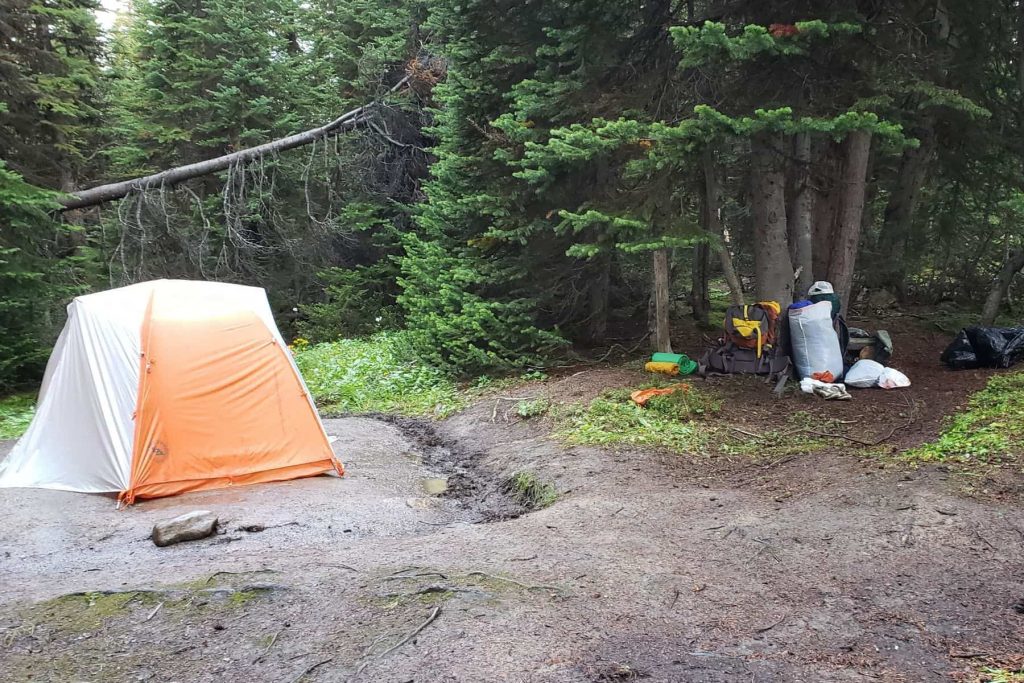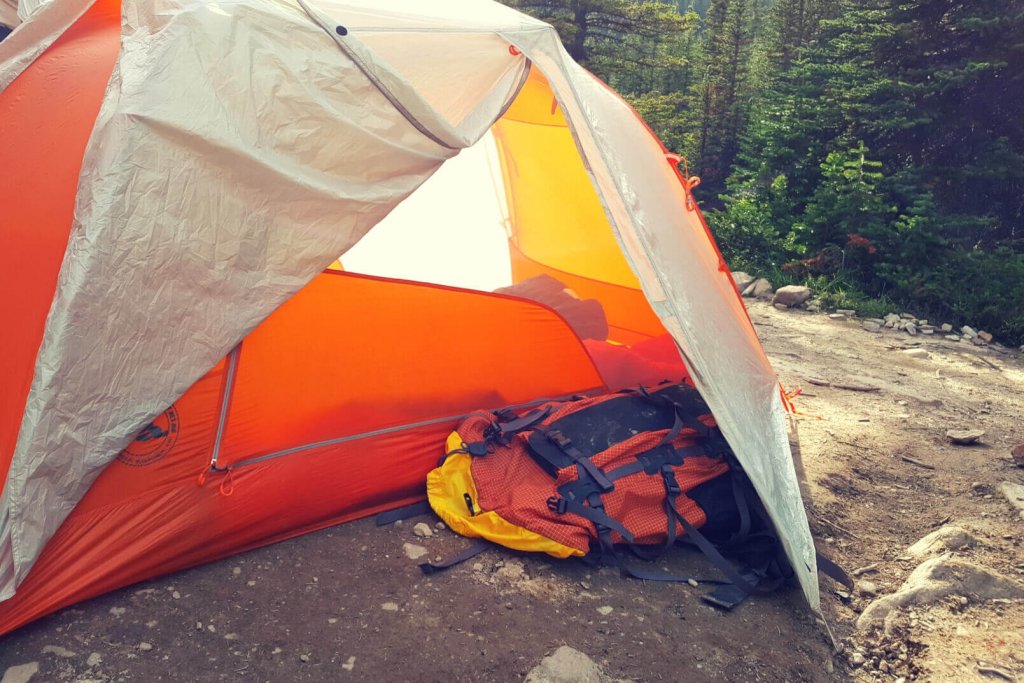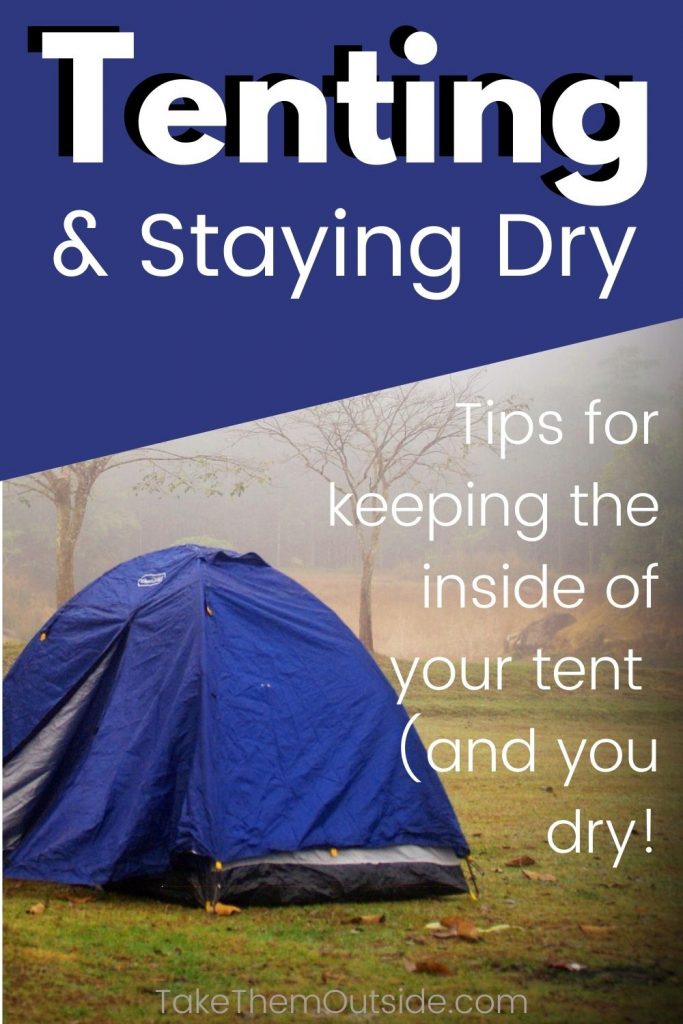Nothing is much worse than sleeping in a cold wet tent. Well, maybe a few things might be worse, but seriously, knowing how to stay dry in a tent is a must if tenting is your jam!
There are a lot of factors that can make or break a camping trip. Don’t let a cold, wet sleep be one of them!
In this article, you will find tips to help you stay dry all night long to make sure your tenting experience is a great one.

This article focuses mostly on what you, the sleeper, can do to stay dry… but, if you’re looking for more tips, you’ll want to read how to tent in the rain for even more tips on keeping you and your tent dry when camping.
How to keep your tent dry inside from condensation
First, why does moisture occur in the tent?
Have you ever woke in a tent wondering why everything feels wet? Or, perhaps you’ve rubbed against the tent wall and gotten your sleeve damp? Or maybe you’ve worried that your tent leaks… but then realize it’s not even raining out?
In order to keep the inside of the tent dry, it is useful to understand why moisture forms in tents in the first place.
The main source of moisture in the tent is condensation from your breath.
Did you know that while you sleep in the tent, you release approximately 1 liter of water (as vapor) out of your body with your breath during the night? If two people are staying in a tent, this amount will be doubled. This vapor then is being trapped at the top of the tent and since the air outside is cooler than the air inside the tent at night, the vapor hitting the top fabric cools and condenses.
This situation is somewhat equivalent to the formation of water droplets on a cold water bottle that has just been taken out of the refrigerator in hot weather.
How to stop condensation in tents?
Provide some ventilation!
Does your tent have a small window vent on the side of your tent? Unless you find yourself in a crazy rain storm, it’s always a good idea to leave these open.
If your tent does not have a ventilation window, you can unzip the zippers of the tent doors a little from the top.
Both of these actions help to release the vapor created by breathing and provide ventilation so the moist air can escape the inside of the tent.
Many quality 3 season tents will have been designed with ventilation in mind. They’ll have vent flaps which can be opened and closed at both the bottoms and tops of the tent in order to create some air flow in hopes of decreasing condensation within the tent.
When you do not ventilate your tent sufficiently (or forget to open your air windows), you may find yourself in an ice cave when you wake up in the morning as a result of the steam formed at night condensing on the tent walls and freezing.
Other tips to help keep your tent dry inside
1. Do not pitch your tent near water sources
If you are camping in an area near water such as a stream, lake, or sea, I recommend you to set up your tent a little further away and higher than the water source.
With the cooling air at night, moisture will settle in low areas. Even 5-10 meters of height can give you an advantage.
Also, pay attention to the ground’s moisture too. Does the ground look damp or wet in certain areas? Can you find a spot that looks dryer than the rest?
2. Do Not Cook in the Tent
Prepare food and drinks outside the tent, especially if you’re using a stove. Otherwise, the released steam will condense inside the tent.
Also, preparing food inside a tent is a huge animal attractant risk… especially in bear country. Just don’t do it! – read more about bear smarts here.
3. Have Dry clothes available
Never sleep with the clothes you wore all day long.
Having dry clothes waiting for you to wear in your tent will allow you to enter the sleeping bag dry. A pair of socks, a comfortable pajama set, and a hat to keep your head warm will be sufficient for a comfortable sleep.
When thinking about your clothes, you might also want to consider the fabrics. Synthetic or woolen fabrics will be best at both keeping you warm and wicking any moisture or sweat away from your skin. When choosing clothes, it’s best to stay away from cotton fabric.
4. Quality Sleep Set-up
Sleeping bags are the most important layer to protect you from cold at night, so they must be kept dry. This means it is very much worth your money to buy a waterproof bag for your sleeping bag especially if you’re backpacking with it.
If you are using a down insulated sleeping bag (these are insulated with goose or duck feathers), they tend to lose their thermal insulation if wet, causing you to spend a cold night.
Synthetic sleeping bags, on the other hand, have higher insulation properties compared to down sleeping bags when they get wet due to their insulation material.
Using a quality sleep pad will also help keep you warm and dry.
Here are some more tips on staying warm in your sleeping bag.
5. Air out your gear
If you have been camping in wet weather and are able, take the time to open up your tent flaps and to let your tent and sleep gear get some air. If you have somewhere dry outside of your tent you can even bring your sleeping bag outside to let it dry fully in the sun and breeze.
Throw them onto a picnic table, or hang them over a branch or onto some bushes. Just make sure to stay close by in case the weather changes.

Last Tips for Keeping the inside of your tent dry
Things to Do Before Entering the Tent:
- Before entering the tent, thoroughly clean off any snow or peel off wet clothes
- Take off your boots and put them in the vestibule before entering the tent. If you leave them outside you may not find them again (been there, done that, learned the lesson!)
- Make sure your vents are open, your tent fly is secured and not resting against the body of the tent
Things Not to Do when in the tent:
- Try not to touch the tent walls while sleeping, especially if you sleep without a sleeping bag
- Keep clothes, gear, and bodies away from the walls of the tent
- Do not breathe in the sleeping bag to get warmer, this will cause the humidity in the bag to increase
A good night’s sleep is dependent on a lot of things, don’t let condensation and a wet night happen by following some of these simple tips above!
Written by Kaan
Outdoor EnthusiastKaan’s biggest passion is to camp in the most beautiful places in the world. You can see his adventures on his site Outdooreager.
More tenting articles you’ll want to read:




